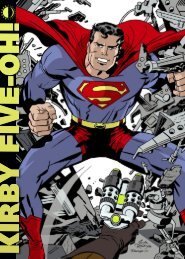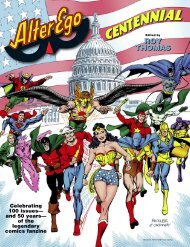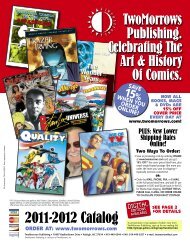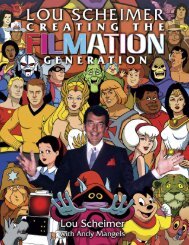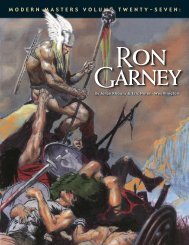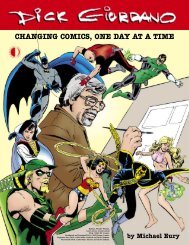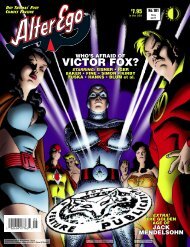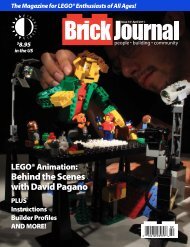JENETTE KAHN - TwoMorrows Publishing Store
JENETTE KAHN - TwoMorrows Publishing Store
JENETTE KAHN - TwoMorrows Publishing Store
You also want an ePaper? Increase the reach of your titles
YUMPU automatically turns print PDFs into web optimized ePapers that Google loves.
Kids’ Stuff<br />
Kahn’s first magazine creation, Kids Magazine,<br />
is extremely hard to find in today’s collectors’ market.<br />
Kids © the respective copyright holder. Sesame Street TM & © Sesame Workshop.<br />
THE YOUNG PUBLISHER<br />
<strong>KAHN</strong>: It was such a gift. It was so amazing that a professor would<br />
say that and believe that and support me. So when I was floundering<br />
and thinking that the solution to supporting myself might lie in a<br />
PhD. I thought I could call Professor Rosenfield and he’d welcome me<br />
back at Harvard with open arms.<br />
But when I phoned, he said, “Oh, I that is the worst idea I have<br />
ever heard. PhDs are so narrow and boring.” [chuckles] I said,<br />
“Professor Rosenfeld, you have a PhD. You’re not that bad.” And he<br />
replied, “You should have seen me before my PhD.” After I pressed<br />
him further, he finally said, “Look, I will grudgingly accept your<br />
application, but this is mid-year. We don’t take anybody mid-year.<br />
You’d have to wait until September.”<br />
I was so eager to find a place to land that I applied to B.U. [Boston<br />
University], and even though it was mid-year, they accepted me. But<br />
truthfully, Professor Rosenfeld was right, and going to school was not<br />
what I really wanted to do. Professor Rosenfeld had also advised me,<br />
“Your sweep is much larger. If you insist on being in the art world, be<br />
a culture critic, but don’t be a professor, don’t be just an art historian.”<br />
And again, I’m so grateful to him. When the Modern’s fellowships<br />
came up, he said something completely out-of-the-box to me.<br />
[chuckles] And now, for a second time, he was saying something<br />
else that was completely out-of-the-box. Professor Rosenfeld saw<br />
something in me that I hadn’t yet seen in myself, a love of something<br />
bigger, of making something happen on a larger canvas. But I had<br />
yet to understand that. I was still in school pursing a PhD, although<br />
not very seriously at all.<br />
At the same time, a friend of mine, James Robinson, was at the<br />
Harvard Ed. School where, as part of the curriculum, he was student<br />
teaching. James loved the whole process of publishing—choosing the<br />
typeface, the paper stock, the end papers—and he was printing the<br />
work of aspiring writers in the Cambridge area. When he encountered<br />
the work of his kids in his classroom, he wanted to publish that, too.<br />
James’ idea was to print a series of books called Young Words and Pictures<br />
that would be entirely written and illustrated by kids for each other.<br />
We were just chatting, so I volunteered, “That’s a great idea. But just<br />
because I like Jim Robinson’s books doesn’t mean I’m going to like Jenette<br />
Kahn’s books. That means every time you publish a new book, you’ll have<br />
to spend a large amount of money to promote and market it. But if this<br />
were a magazine with surprises to keep it fresh and with ongoing features<br />
that kids would look forward to, you’d have a built-in audience. From a<br />
business point of view, I think that that would be more successful.”<br />
Suddenly I, who knew absolutely nothing about business, was an expert!<br />
And James said, “Well, great. Write a prospectus.” [Bob chuckles]<br />
I didn’t even now what a prospectus was, and whatever I wrote<br />
was surely not a prospectus, but I typed up something about the<br />
magazine. My own art style peaked at ten, so I was able to make<br />
reasonably faithful reproductions of the kids’ art and paste them into<br />
a ridiculously crude dummy to accompany my [chuckles] pseudoprospectus.<br />
Young Words and Pictures sounded a little stuffy, so we<br />
changed the title of the magazine to Kids.<br />
James and I were able to persuade two Boston businessmen,<br />
Charlie Rheault and Steve Alpert, to come on board, and they, in<br />
turn, were able to get us a $15,000 loan from the First National<br />
Bank of Boston. One of them knew a large printer in Lowell,<br />
Massachusetts, called Courier Color. Some karma was at work here,<br />
because many years before, when my father was a boy, he’d sold<br />
Courier Color newspapers on the street corners of Lowell. There was<br />
a lovely man at Courier Color named Dale Bowman, who was the<br />
foreman of the plant. He fell in love with the idea of Kids and generously<br />
arranged for us to print it on credit.<br />
Everything in the magazine was written and illustrated by kids<br />
and we had kids as editors, too. And in advance of publication,<br />
we had put together an advisory board of the vanguard educators of<br />
the time: Dr. Robert Coles, John Holt, Jonathan Kozol, Kenneth Koch,<br />
the poet; Betty Blayton Taylor of the Children’s Art Carnival in Harlem.<br />
Eventually, the magazine generated its own submissions, but in<br />
the beginning we went to schools in Boston and New York to find the<br />
first paintings, stories, poems, and photographs we would publish. Our<br />
advisory board gave us credibility and we were aided by a sea change in<br />
educational thinking. Teachers across the country were realizing that<br />
their young students had tremendous creative potential and believed that<br />
potential should be validated and nurtured. The time was right for Kids.<br />
There was a three-week gap between the time that Kids was printed<br />
and its distribution on the newsstand. With printed copies in hand,<br />
I used that gap to garner publicity for the magazine.<br />
There was a wonderful columnist for The New York Times named<br />
Joseph Lelyveld. He went on to become the Times’ executive editor, but<br />
at that time he was writing the most compelling series of articles about a<br />
4th grade class in a school on the borderline of Harlem and the Upper East<br />
Side. Joe’s stories were often revelatory, always moving, and sometimes<br />
very funny. Because of the immense humanity in his articles and his clear<br />
respect for the students whose classroom adventures he detailed every<br />
week, I thought Joe might respond to Kids and consider writing about it.<br />
My father and Joe’s father had both been college campus rabbis<br />
with the B’nai B’rith Hillel Foundation, and on the strength of that,<br />
I got in touch with Joe. “Would he meet with me?” I asked and Joe<br />
graciously said yes. A few days later we had coffee in the New York<br />
Times cafeteria and I showed him the magazine.<br />
“I don’t think the Times would write about this,” said Joe, “but if<br />
it did write about Kids, I would not be the person. Again, I don’t<br />
think that this is for the Times, but I will give the magazine to the<br />
appropriate people.” I expected nothing to come from the meeting,<br />
but two weeks later, on a Sunday morning in the fall [November 15,<br />
1970], I woke up and there were some five columns about Kids<br />
Magazine in The New York Times.<br />
J e n e t t e K a h n I s s u e • B A C K I S S U E • 5



